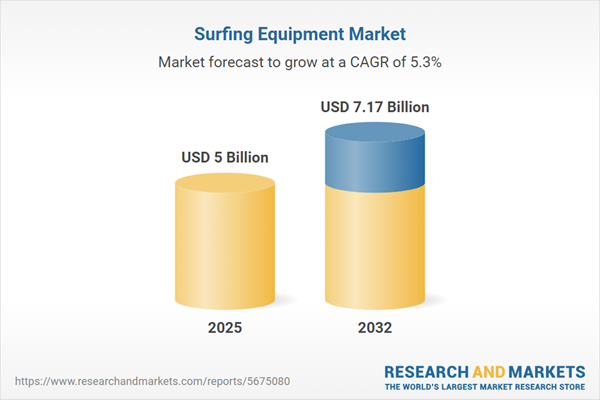Speak directly to the analyst to clarify any post sales queries you may have.
The global surfing equipment market is evolving rapidly, driven by significant advancements in technology, sustainability, and changing consumer behaviors among both enthusiasts and industry leaders.
Market Snapshot: Surfing Equipment Market Size & Growth
The Surfing Equipment Market grew from USD 4.74 billion in 2024 to USD 5.00 billion in 2025. It is expected to continue expanding at a CAGR of 5.29%, reaching USD 7.17 billion by 2032. This upward trend underscores strong momentum in product innovation, environmental stewardship, and strategic channel diversification, positioning the market for sustained global expansion.
Scope & Segmentation of the Surfing Equipment Market
This research offers a comprehensive breakdown of the surfing equipment landscape, reflecting the complex needs of participants and shifting technological standards. Key segmentation and coverage areas include:
- Product Categories: Surfboards (fish, gun, longboard, shortboard, soft top), accessories, fins, leashes, wax, wetsuits (full suit, springsuit, vest)
- Distribution Channels: Online retail, specialty surf shops, sports goods stores
- Price Tiers: Economy, mid range, premium
- Skill Levels: Beginner, intermediate, expert
- Gender: Female, male
- Age Groups: Adult, youth, child
- Regions: Americas (North America: United States, Canada, Mexico; Latin America: Brazil, Argentina, Chile, Colombia, Peru), Europe, Middle East and Africa (Europe: United Kingdom, Germany, France, Russia, Italy, Spain, Netherlands, Sweden, Poland, Switzerland; Middle East: United Arab Emirates, Saudi Arabia, Qatar, Turkey, Israel; Africa: South Africa, Nigeria, Egypt, Kenya), Asia-Pacific (China, India, Japan, Australia, South Korea, Indonesia, Thailand, Malaysia, Singapore, Taiwan)
- Leading Companies: Boardriders, Inc.; Billabong International Limited; Rip Curl International Pty Ltd; Hurley International LLC; O'Neill Wetsuits, LLC; Patagonia, Inc.; Channel Islands Surfboards, Inc.; Firewire Surfboards, Inc.; Lost Enterprises, Inc.; FCS International Pty Ltd
Key Takeaways: Strategic Imperatives for Senior Decision-Makers
- Sustained product evolution has focused on balancing gear performance, long-term durability, and environmental responsibility, supported by material science innovations such as high-modulus fiber composites and eco-friendly wetsuit alternatives.
- Distribution strategies blend digital and physical channels, meeting diverse user needs—online retail and customization platforms serve convenience-driven consumers, while specialty shops provide in-person fittings and experiential engagement.
- The market’s structure accommodates granular segmentation across price, skill, gender, and age, ensuring customer-centric product alignment throughout the user lifecycle.
- Collaboration between material scientists and environmental organizations is reshaping competitive advantage, as traceability and sustainability criteria increasingly influence procurement and production decisions.
- Direct-to-consumer strategies, data-driven design, and real-time digital feedback loops are fostering greater brand loyalty, speed-to-market, and adaptive innovation cycles.
Tariff Impact: Navigating Cost Structures and Supply Chains
New U.S. tariff measures have increased input costs for imported composite materials and finished products, forcing many manufacturers to revisit sourcing, localize production where possible, and seek tariff mitigation strategies. Retailers face margin pressures, especially on high-value performance categories, but agile brands are adapting through proactive inventory and supply chain management, including vertical integration and partnerships with tariff specialists.
Methodology & Data Sources: Rigorous Approach to Surfing Equipment Analysis
The report combines primary interviews with product designers, supply chain leaders, and industry executives with structured consumer surveys. This is reinforced by secondary sources such as material science journals, patent filings, and regulatory disclosures. Analytical techniques include multivariate cluster analysis and trend triangulation, supported by iterative expert review cycles to validate findings.
Why This Report Matters: Decision-Ready Insights for the Surfing Equipment Market
- Enables strategic planning by mapping emerging growth areas by product, channel, and region, allowing decision-makers to prioritize opportunities confidently.
- Highlights actionable strategies for mitigating supply risks, embracing sustainable material innovations, and targeting new user segments based on skill, age, and gender.
Conclusion
Senior leaders navigating the surfing equipment sector gain a clear framework for market entry, investment, and product development that aligns with evolving technologies and consumer needs. Stakeholders equipped with these insights can drive competitive advantage and long-term value in this dynamic industry.
Additional Product Information:
- Purchase of this report includes 1 year online access with quarterly updates.
- This report can be updated on request. Please contact our Customer Experience team using the Ask a Question widget on our website.
Table of Contents
3. Executive Summary
4. Market Overview
7. Cumulative Impact of Artificial Intelligence 2025
List of Figures
Samples

LOADING...
Companies Mentioned
The key companies profiled in this Surfing Equipment market report include:- Boardriders, Inc.
- Billabong International Limited
- Rip Curl International Pty Ltd
- Hurley International LLC
- O'Neill Wetsuits, LLC
- Patagonia, Inc.
- Channel Islands Surfboards, Inc.
- Firewire Surfboards, Inc.
- Lost Enterprises, Inc.
- FCS International Pty Ltd
Table Information
| Report Attribute | Details |
|---|---|
| No. of Pages | 193 |
| Published | October 2025 |
| Forecast Period | 2025 - 2032 |
| Estimated Market Value ( USD | $ 5 Billion |
| Forecasted Market Value ( USD | $ 7.17 Billion |
| Compound Annual Growth Rate | 5.2% |
| Regions Covered | Global |
| No. of Companies Mentioned | 11 |









